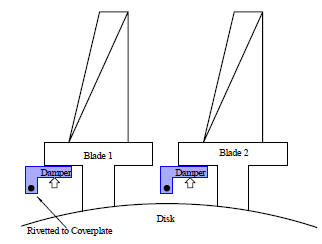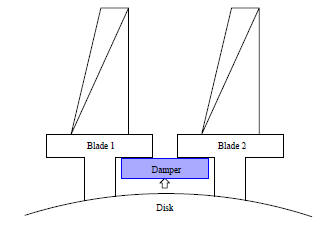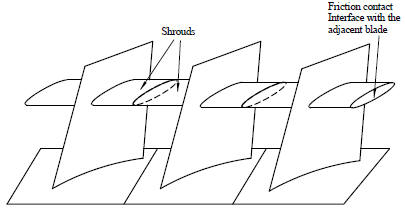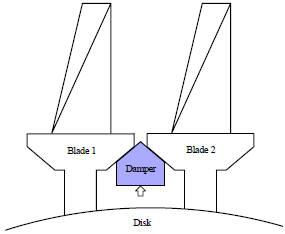






|
|
RESEARCH INTERESTS
-
Nonlinear Vibration Analysis
-
Friction Contact Modeling
Friction Damping, Dry Friction Damper
-
Vibrations of Gas Turbine
Engine Blades
/ Bladed Disk Systems
Linear and Nonlinear Forced Response Prediction of Bladed-Disks (Tuned /
Mistuned)
-
Mistuning Identification
in Gas Turbine Engines
-
Automotive Engineering
-
Gear Dynamics
-
Vibration Damping, Vibration Isolation
-
Vibrations of Carbon Nanotubes
-
Nonlinear Vibrations of Continuous Systems
Large Scale Vibrations of Beams
-
Helicopter Blade
Vibrations
Vibration Damping of Helicopter Blades
-
Dynamic Analysis and Control of Engineering
Systems
-
Analysis of Systems with Fluid-Structure Coupling
-
Numerical Methods for the Analysis of
Nonlinear Systems
INTERESTED IN MS or PHD STUDIES?
Looking
for 3 funded PhD students for TUBITAK 2244 Program in collaboration
with Turkish Aerospace (TAI).
See the details.
Looking for a graduate student to work on "Modeling
Dynamic Cutting Process Micro-Machining" who will be
jointly supervised by
Dr. Ender Cigeroglu (METU) and
Dr. Bekir Bediz (Sabanci Univ.).
If you are interested in this joint research,
follow the link. (01/03/2019)
Joint Research Opportunity
between
Middle East Technical University and
Georgia Institute of Technology.
If you are interested in this joint research, follow the
link.
Looking for a graduate student to work on "Nonlinear
Piezoelectric Energy Harvesting" who will be
jointly supervised by
Dr. Ender Cigeroglu (METU) and
Dr. Alper Erturk (Georgia Tech).
Looking for Graduate Students (MS or PhD) Who Would
Like to Work on
Automotive Engineering,
Vibrations of Bladed Disks, Gear dynamics, and VIBRATIONS of MICRO & NANO Structures! For Other Research Topics, Please
See the Link Given Below.
You may e-mail or call
me. Follow the Link for Details
on Research Topics.
Examples of Current MS and PhD Thesis Titles are
Listed Below. Note that research subjects are not limited to the
ones given below.
Broadband Energy Harvesting using Nonlinear
Structures
Nanoscale Linear and Nonlinear Energy
Harvesting
Tuned Liquid Column Damper
Vibration Isolation of Structures Using
Nonlinear Elements
Nonlinear Vibrations of CNT based Mass
Sensors
Nonlinear Vibrations of FGM Micro/Nano Beams/Plates
SUMMARY OF RESEARCH
ACTIVITIES ON VIBRATIONS OF GAS TURBINE ENGINE BLADES
The research activities in
Vibrations Laboratory are mainly focused on linear and nonlinear
vibrations of turbine blades (gas turbine engines and steam turbines).
We are interested in developing tools for accurate modeling of friction
contact and its effect on blade vibration, identification of mistuning
and nonlinear vibrations of tuned and mistuned bladed disk systems.
One of the major problems in the design of gas turbine
engines is the High Cycle Fatigue (HCF) failure of turbine blades due to
blade resonance in the operating range. It is reported that HCF failure
of engine blades is responsible for more than 50 % of the major
engine failures.
Dry friction dampers are commonly used by engine
manufactures in order to decrease vibration levels and increase fatigue
lives. There are several types of friction dampers used by the gas
turbine engine manufacturers, which can be categorized in the following
groups: blade-to-ground dampers, blade-to-blade dampers, shrouds and
underplatform dampers.
Blade-to-ground damper, where damper is in contact with
the coverplate or the disk, is stationary with respect to the blade, and
energy is dissipated through the friction contact due to the relative
motion between the blade and the so-called ground. On the other hand, in
blade-to-blade damper, damper is pushed against the adjacent blades and
energy is dissipated due to the relative motion between the adjacent
blades.
Shroud dampers can be considered a special type of
blade-to-blade dampers which can also increase the overall stiffness of
the blades. During engine operation, shrouds come into contact and
energy is dissipated due to the relative motion at the contact
interface.
Underplatform dampers can as be considered as a special
group of blade-to-blade dampers where the damper is placed under the
blade platforms and comes into contact with the blade due to the
centrifugal forces. Wedge damper is a commonly used underplatform damper
type where the damper has two inclined surfaces in contact with the
adjacent blades. It is also referred as cottage-roof damper. Due to
centrifugal forces created by the rotation of the engine, the damper
contacts with the adjacent blade platforms and energy is dissipated at
the two friction surfaces due the relative motion between the blades and
the damper. However, due to the nonlinear nature of dry friction,
dynamic analysis of the system becomes complicated.
Some other examples of underplatform friction dampers
are cylindrical dampers and cylindrical wedge dampers. In the first one
the wedge damper is replaced with a cylindrical damper; whereas, in the
later one one side of the wedge damper has a circular form and the other
side is an inclined surface. It should be noted that dry friction is a
nonlinear phenomenon which complicates the dynamic analysis of the
bladed disk system. In order to accurately predict the forced response
of turbine blades, accurate modeling of friction contact and dynamics of
the bladed disk system with friction dampers are necessary.
 |
 |
 |
 |
| Schematic for
Blade-to-Ground (left) and Blade-to-Blade (right) Dampers: In
these dampers the normal load is optimized in order to obtain
the minimum
response. |
Schematic for Shroud Damper:
At each shroud pair, the number of contact areas and the angle
of these contact areas (with respect to blades) are optimized in
order to obtain maximum friction damping. |
Schematic for Wedge Damper: Damper
weight (normal load) and the angle of the inclined surfaces and
platforms are optimized in order to minimize vibratory motion of
the blades. Angles at right and left inclined surfaces can be
different as well. |
In addition to friction dampers, it is also important to
identify mistuning in the bladed disk system. Bladed disk systems are
cyclically symmetric structures (composed of cyclic repetition of a
sector); however, due to manufacturing tolerances and inhomogeneous
material distribution, wear, etc., this cyclic symmetry is lost, which
is called as mistuning. Unlike tuned systems, energy localization occurs
in mistuned systems that results in increased vibration amplitudes in
some of the blades which causes shorter HCF lives. In order to
accurately predict, and improve HCF lives of turbine blades, it is
necessary to identify mistuning in the manufactured bladed disks.
The last version of the computer code BDamper (v10) has
been developed during my PhD study at the Ohio State University, which
is a collection of computer codes developed at CMML for Forced Response
Prediction of Bladed Disks. The research activity at OSU was supported
by a GUIde Consortium including
General Electric, Pratt & Whitney,
Mitsubishi, Siemens, Air Force Research Laboratories (AFRL) and funded
by AFRL. The developed computer code BDamper v10 (last version) is
delivered to these companies and labs which is also purchased by
Rolls-Royce later.
The research activities in Vibrations Laboratory are
mainly focused on linear and nonlinear vibrations of turbine blades. We
are interested in developing tools for accurate modeling of friction
contact and its effect on blade vibration, identification of mistuning
and nonlinear vibrations of mistuned bladed disk systems. For this
purpose, we conduct research with highly motivated students some of
which are sent to Rolls-Royce in UK for 6 months in order to identify
and be familiar with current problems of the industry.
RESEARCH PROJECTS
-
Effect of Double Cardan Shaft on the Vibration of Armed Military
Vehicle Suspension, SAYP-FNSS,
Principal Investigator,
13/10/2015-13/10/2017.
-
Türk Traktör,
Consultant,
10/01/2015-10/01/2016.
-
Development of Reduced Order Models for the Dynamics Analysis of
Mistuned Blade Disk Systems, DKTM
(TAI-TEI), Principal Investigator,
22/12/2014-22/06/2017 (with
Prof. Dr. H. Nevzat Özgüven).
-
Development of a Sensitivity Based Model Updating Software, SAYP-ROKETSAN,
Co-Principal Investigator,
15/12/2014-15/06/2016 (with co-principal
investigator Assist. Prof. Dr. Gökhan O. Özgen)
-
Development of a Methodology to Estimate Torque Loss in bolted
Joints, TOFAŞ,
Principal Investigator,
10/06/2013-31/12/2014.
-
Reduction of Dynamic Transmission Error by Profile Modifications in
Spur Gears, SAYP-TAI,
Co-Principal Investigator, 15/09/2012-15/09/2016
(with co-principal investigator Prof. Dr. H. Nevzat
Özgüven).
-
Rotor Dynamics and Application of Squeeze Film Damping,
TEİ, Consultant,
07/2012-04/2013 (with
Prof. Dr. H. Nevzat Özgüven).
-
Design of an Active Vibration Control System,
Researcher, ROKETSAN,
12/2011-05/2012, (with Assist. Prof.
Dr. Gökhan O. Özgen ve Assist. Prof. Dr. Yiğit Yazıcıoğlu)
-
Blade Diagnostics,
Consultant,
09/2011-12/2011.
-
Development and Testing of Passive Vibration Dampers in order to
Increase Vehicle Ride Comfort (Araç Sürüş Konforunun Artırılması
İçin Pasif Titreşim Sönümleyicilerinin Geliştirilmesi Ve Test
Edilmesi),
TÜBİTAK 1001, Principal Investigator,
04/2011-10/2013. (with
Dr.
S. Çağlar Başlamışlı and Asst. Prof.
Dr. Gökhan O. Özgen)
-
Coordinated Guidance of Multiple Unmanned Aerial Vehicles (UAVs) and
path Planning (Çoklu İnsansız Hava Aracının (İHA) Koordineli Güdümü
ve Yol Planlama),
TÜBİTAK 1001, Researcher, 04/2011-04/2014.
-
Development of Turbotek High Performance Wind Turbine Commercial
Product, TURBOTEK,
Consultant,
10/2010-05/2012.
-
Design of a Spacer Damper for Power
Transmission Lines, ODAGEM, Consultant (with Asst. Prof.
Dr. Gökhan O. Özgen), 04/2010-08/2010.
-
Design of an Engine Mount,
TOFAŞ Türk Otomobil Fabrikası
A.Ş., Principal Investigator,
2009-2010.
-
Development
of Friction Models, METU BAP Project,
Principal Investigator,
2009-2012.
-
Kara Hedef
Angajmanı için Milimetrik Dalga Radar Teknikleri Geliştirilmesi
Projesi MİLDAR, METEKSAN Defence
A.Ş., TÜBİTAK 1007 Project,
Researcher (with Asst. Prof.
Dr. Gökhan O. Özgen), 2008-2010.
-
Generator
Shaft Critical Speed and Unbalance Vibration Analysis,
Diler Elektrik A.Ş.,
Consultant (with Asst. Prof.
Dr. Gökhan O. Özgen), 04/2009-05/2009.
CURRENT RESEARCH
GROUP
CURRENT GRADUATE STUDENTS
-
Sinem DEMİRKAYA, TAI,
(Ph.D.)
-
Ali Çağrı BATIHAN,
Research Assistant
(Ph.D.)
-
Behrang Hosseiniaghadam,
(Ph.D.)
-
Sefa KIZILAY,
(Ph.D.)
-
Hossein
Soleimani, EU Project Research
Assistant (Ph.D.,
Supervised with Prof. Dr. H. Nevzat Özgüven)
-
Bekir Mert
Özceylan, ASELSAN
(MS, Supervised
with Assoc. Prof. Dr. Alper Ertürk,
Gerogia Tech)
-
Caner Türker,
ASELSAN (MS, Supervised with Asst. Prof. Dr.
Gökhan
O. Özgen)
-
Cem
Baykal, Research Assistant
(Ph.D., co-supervised with
Assoc. Prof. Dr. Yiğit
Yazıcıoğlu)
-
Hümeyra Beyan,
ROKETSAN (MS)
-
Aykut Çardak,
ROKETSAN (MS)
-
Beste Öztekin,
ROKETSAN (MS,
Supervised with Prof. Dr. H. Nevzat
Özgüven)
-
Furkan Sevencan,
TR Motor (MS,
Supervised with Asst. Prof. Dr.
Özgür Uğraş Baran)
-
Demir Dedeköy,
METEKSAN (MS,
Supervised with Asst. Prof. Dr. Bekir
Bediz, Sabancı University)
-
Ata Tankut Ardıç,
Research Assistant (MS,
Co-supervised with Asst. Prof. Dr.
Özgür Uğraş Baran)
-
Ehsan Naghizadeh, (MS)
-
Yiğitcan Ekici, (MS)
ALUMNI
-
Eren ÖNEY,
ASELSAN (MS)
-
Özgen IŞIK,
FNSS (MS)
-
Cem
Baykal, Research Assistant
(MS, co-supervised with
Assoc. Prof. Dr. Yiğit
Yazıcıoğlu)
-
M. Emin DOĞAN,
ASELSAN (MS)
-
Gökhan KARAPISTIK,
ROKETSAN (MS)
-
Doğancan
Bahan, ROKETSAN (MS)
-
Sefa KIZILAY,
(MS)
-
Muhammed Emre
BİLEN,
TAI (MS,
co-supervised with Prof. Dr. H. Nevzat Özgüven)
-
Ata DÖNMEZ,
ROKETSAN (MS, supervised with Asst. Prof. Dr.
Gökhan O. Özgen)
-
Birkan ÖNAL,
TAİ (MS, Supervised with
Assoc. Prof. Dr. Zihni Burçay Sarıbay, TAİ)
-
Veysel Yalın ÖZTÜRK,
TAI, (Ph.D., co-supervised with Prof. Dr. H. Nevzat Özgüven)
-
Onur SERT, ASELSAN
(MS)
-
Çağrı TEPE,
ASELSAN (MS)
-
Şiar
Deniz Yavuz, TAI (Ph.D.,
Supervised with Assoc. Prof. Dr.
Zihni Burçay Sarıbay, TAİ)
-
Doğuş ÜNLÜ,
ROKETSAN (MS, supervised with Asst. Prof. Dr.
Gökhan O. Özgen)
-
Erhan FERHATOĞLU,
TAI (MS,
co-supervised with Prof. Dr. H. Nevzat Özgüven)
-
Cihan YILDIRIM,
Research Asistant (MS)
-
Onur ÖZAYDIN,
TAI (MS)
-
Reza AGHAZADEH,
THK University (Ph.D., co-supervised
with Assoc. Prof. Dr. Serkan Dağ)
-
Ata ALIPOUR GHASSABI Research
Assistant (MS,
co-supervised with Prof. Dr. Serkan Dağ)
-
Yunus Emre
ÖZÇELİK, GE (MS, Supervised with
Prof. Dr. Mehmet
Çalışkan)
-
Tayfun ÇELİK,
TÜBİTAK
SAGE (MS, Supervised with Assoc. Prof. Dr.
Yiğit Yazıcıoğlu)
-
Hamed Samandari, Research Assistant
(Ph.D.)
-
Ufuk YİĞİT,
Research Assistant (MS, supervised with Prof.
Dr. Erhan Budak)
-
Tuğrul KOZAK,
TÜBİTAK SAGE
(Ph.D., co-supervised with Asst. Prof.
Dr. Yiğit Yazıcıoğlu)
-
Canan UZ (MS, co-supervised with Asst. Prof. Dr. Gökhan O. Özgen)
-
Ozan Yavuz BAYTEMİR,
METEKSAN (MS, supervised with Asst. Prof.
Dr. Gökhan O. Özgen)
-
Reza AGHAZADEH, Research Assistant (MS,
co-supervised with Assoc. Prof. Dr.
Serkan Dağ)
-
Ozan GERGER,
ASELSAN (MS,
supervised with Dr. S. Çağlar Başlamışlı,
Hacettepe University)
-
Anıl KOYUNCU,
ASELSAN (MS, co-supervised with Prof. Dr. H. Nevzat
Özgüven)
-
Burcu ŞAYİN, TAI, (MS)
-
Hasan YILMAZ, ASELSAN, (MS)
-
Hakan ZALOĞLU,
ASELSAN, (MS, co-supervised
with Asst. Prof. Dr. Gökhan O. Özgen)
-
H. Çağlar KARATAŞ,
ROKETSAN, (MS,
co-supervised with Prof. Dr. H. Nevzat Özgüven)
-
Zühtü
EREN,
FNSS, (MS)
-
Yusuf ELDOĞAN,
ASELSAN, (MS)
-
Dilara ÇINAREL, (MS)
-
Ahmet OKYAY,
(MS,
supervised with Inst. Dr. S. Çağlar Başlamışlı)
-
İsmet BARAN,
(MS, co-supervised
with Asst. Prof. Dr. Gökhan O. Özgen)
-
Caner BORAL,
(MS, supervised with Dr.
İbrahim Korkmaz)
-
Göksu AYDAN,
(MS, supervised with
Inst.
Dr. S. Çağlar Başlamışlı)
-
Mehmet Ersin YÜMER, (MS,
co-supervised with Prof. Dr. H. Nevzat Özgüven)
VISITING RESEARCHERS
-
Behrang. H. Aghdam, (Post-Doctoral
Researcher)
-
Behrang. H. Aghdam, (Post-Doctoral
Researcher)
-
Mohammad Rahmanian,
Sharif University of Technology,
Iran (Ph.D.)
-
Behrang. H. Aghdam,
K. N. Toosi University of Technology, Iran
(Ph.D.)
|








